Emergency Management of Adult Smoke Inhalation Injuries
VerifiedAdded on 2023/03/31
|14
|1136
|405
Presentation
AI Summary
This presentation explores the background, prevalence, and pathophysiology of adult smoke inhalation injuries. It also discusses assessment methods and priority interventions for emergency management. The aim is to develop an understanding of the prevalence, assessment, and interventions for adult smoke inhalation injuries. The subject is NURS3101 and the college/university is not mentioned.
Contribute Materials
Your contribution can guide someone’s learning journey. Share your
documents today.
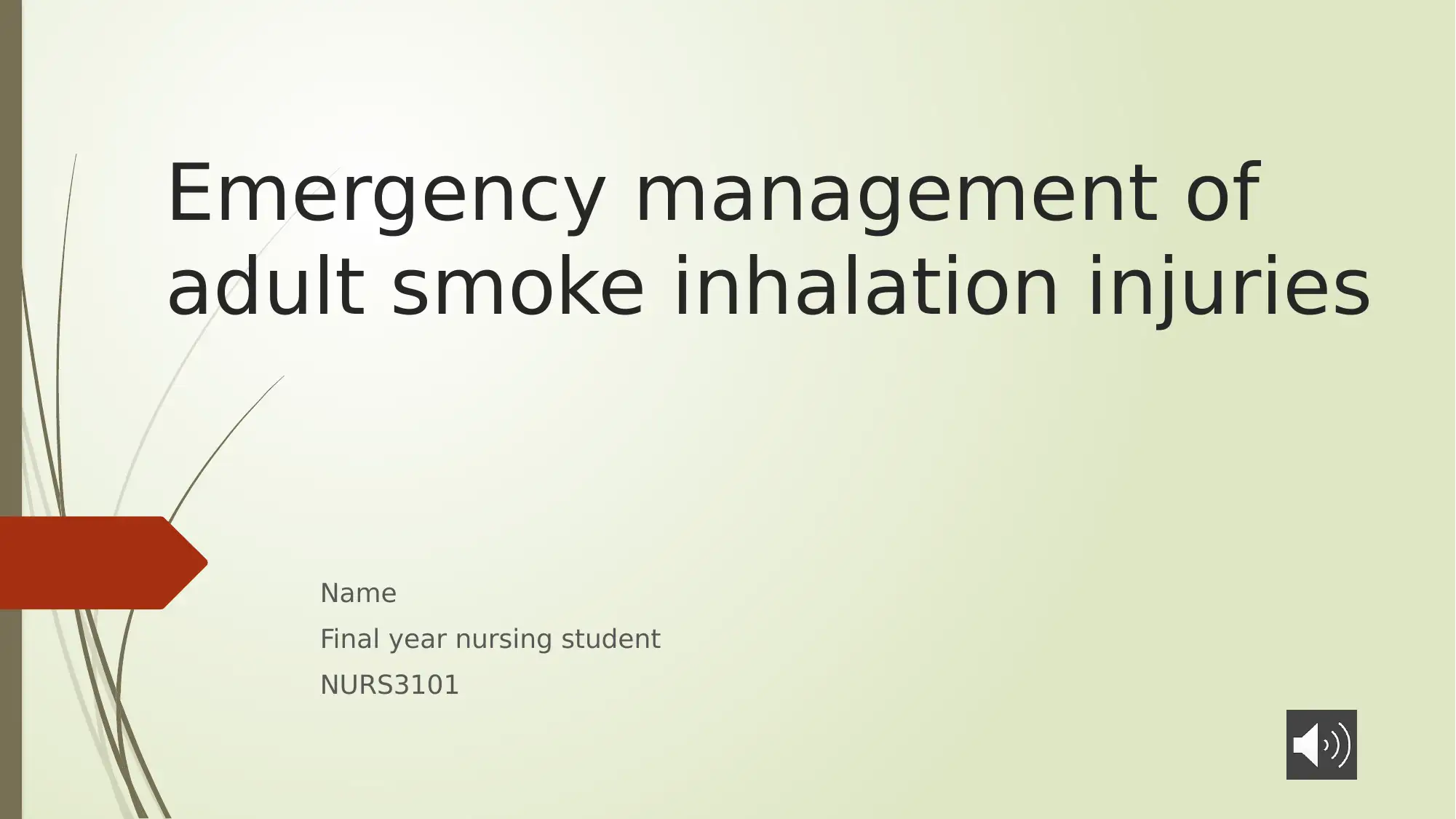
Emergency management of
adult smoke inhalation injuries
Name
Final year nursing student
NURS3101
adult smoke inhalation injuries
Name
Final year nursing student
NURS3101
Secure Best Marks with AI Grader
Need help grading? Try our AI Grader for instant feedback on your assignments.
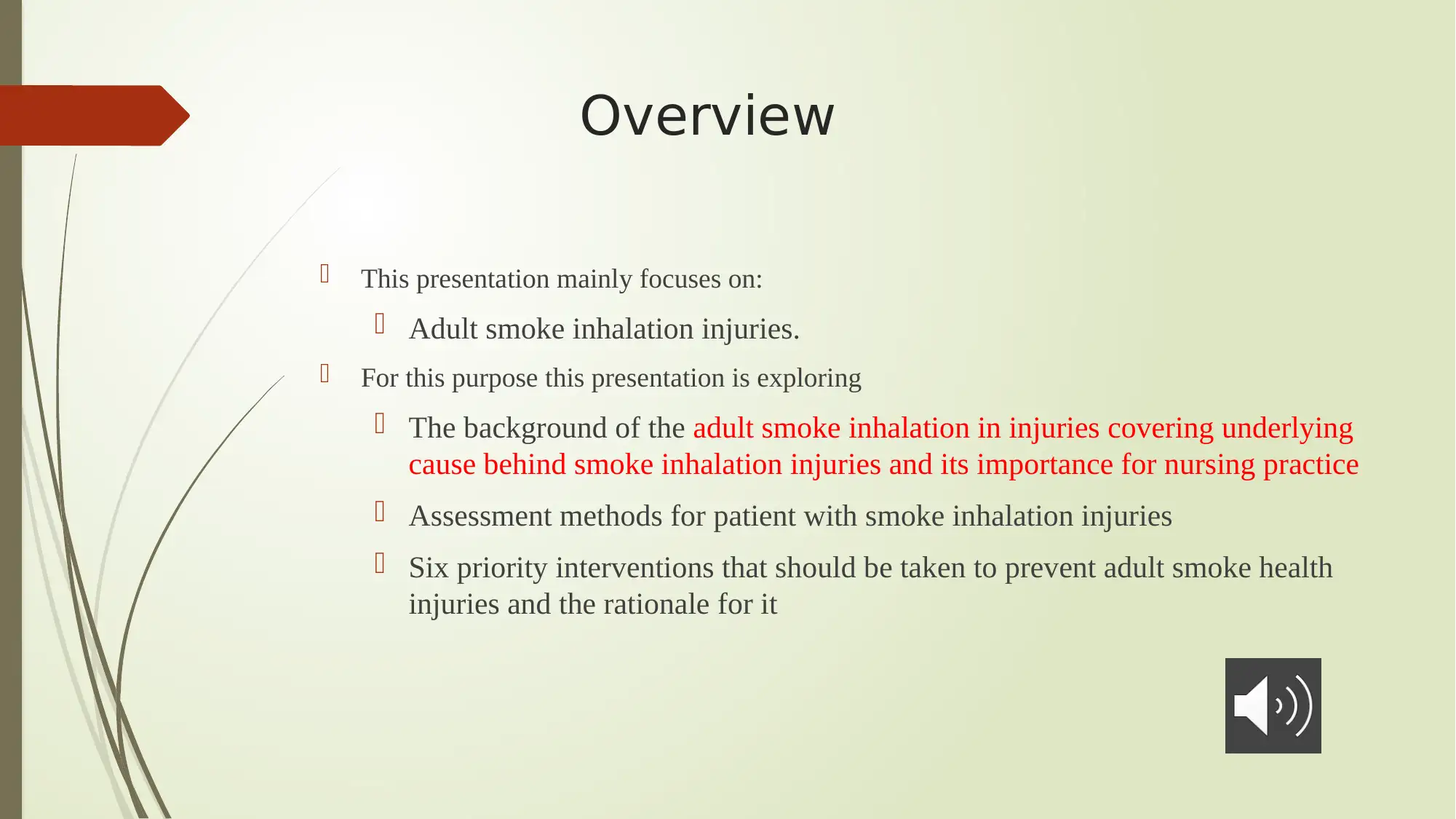
Overview
This presentation mainly focuses on:
Adult smoke inhalation injuries.
For this purpose this presentation is exploring
The background of the adult smoke inhalation in injuries covering underlying
cause behind smoke inhalation injuries and its importance for nursing practice
Assessment methods for patient with smoke inhalation injuries
Six priority interventions that should be taken to prevent adult smoke health
injuries and the rationale for it
This presentation mainly focuses on:
Adult smoke inhalation injuries.
For this purpose this presentation is exploring
The background of the adult smoke inhalation in injuries covering underlying
cause behind smoke inhalation injuries and its importance for nursing practice
Assessment methods for patient with smoke inhalation injuries
Six priority interventions that should be taken to prevent adult smoke health
injuries and the rationale for it
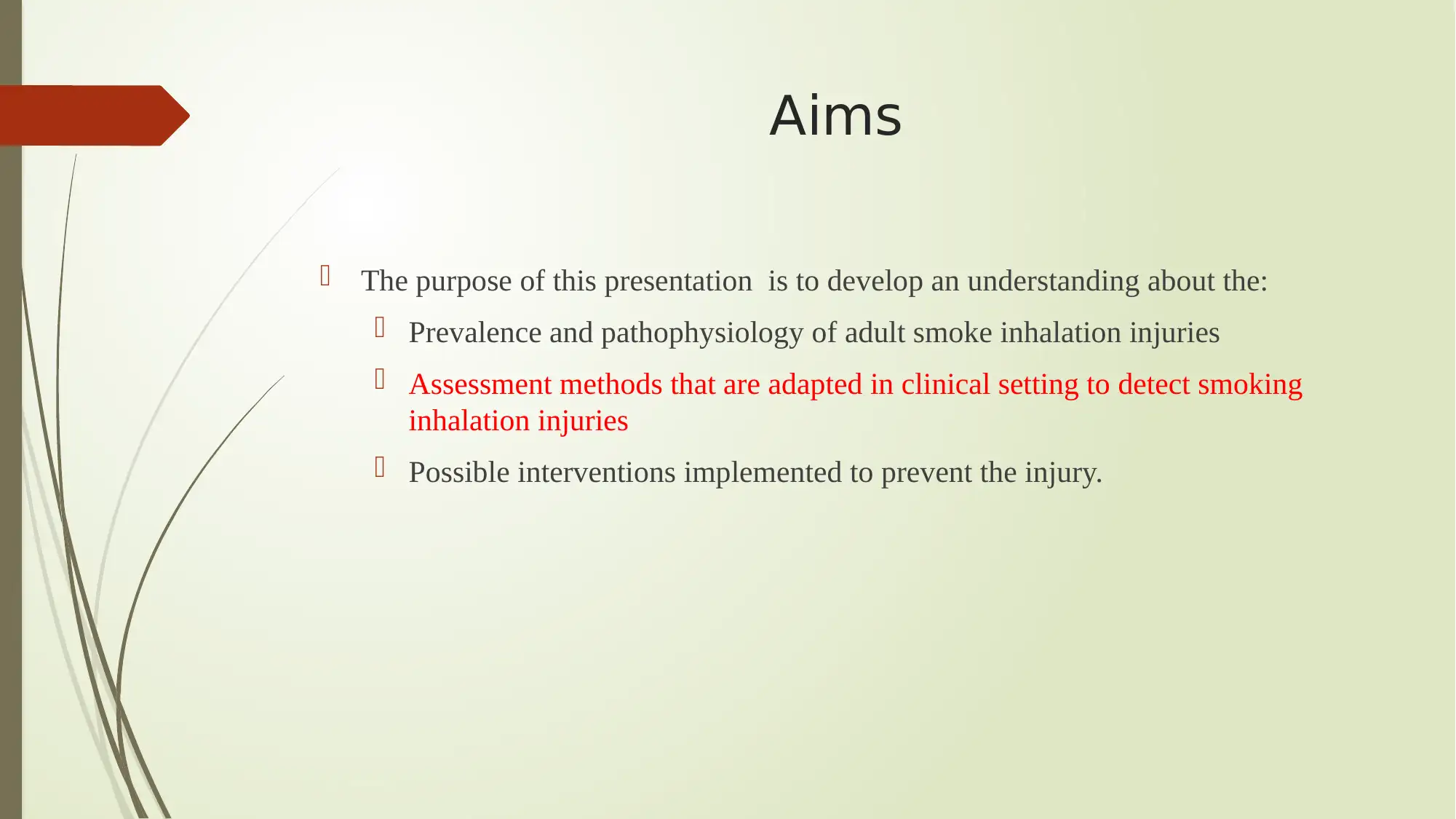
Aims
The purpose of this presentation is to develop an understanding about the:
Prevalence and pathophysiology of adult smoke inhalation injuries
Assessment methods that are adapted in clinical setting to detect smoking
inhalation injuries
Possible interventions implemented to prevent the injury.
The purpose of this presentation is to develop an understanding about the:
Prevalence and pathophysiology of adult smoke inhalation injuries
Assessment methods that are adapted in clinical setting to detect smoking
inhalation injuries
Possible interventions implemented to prevent the injury.
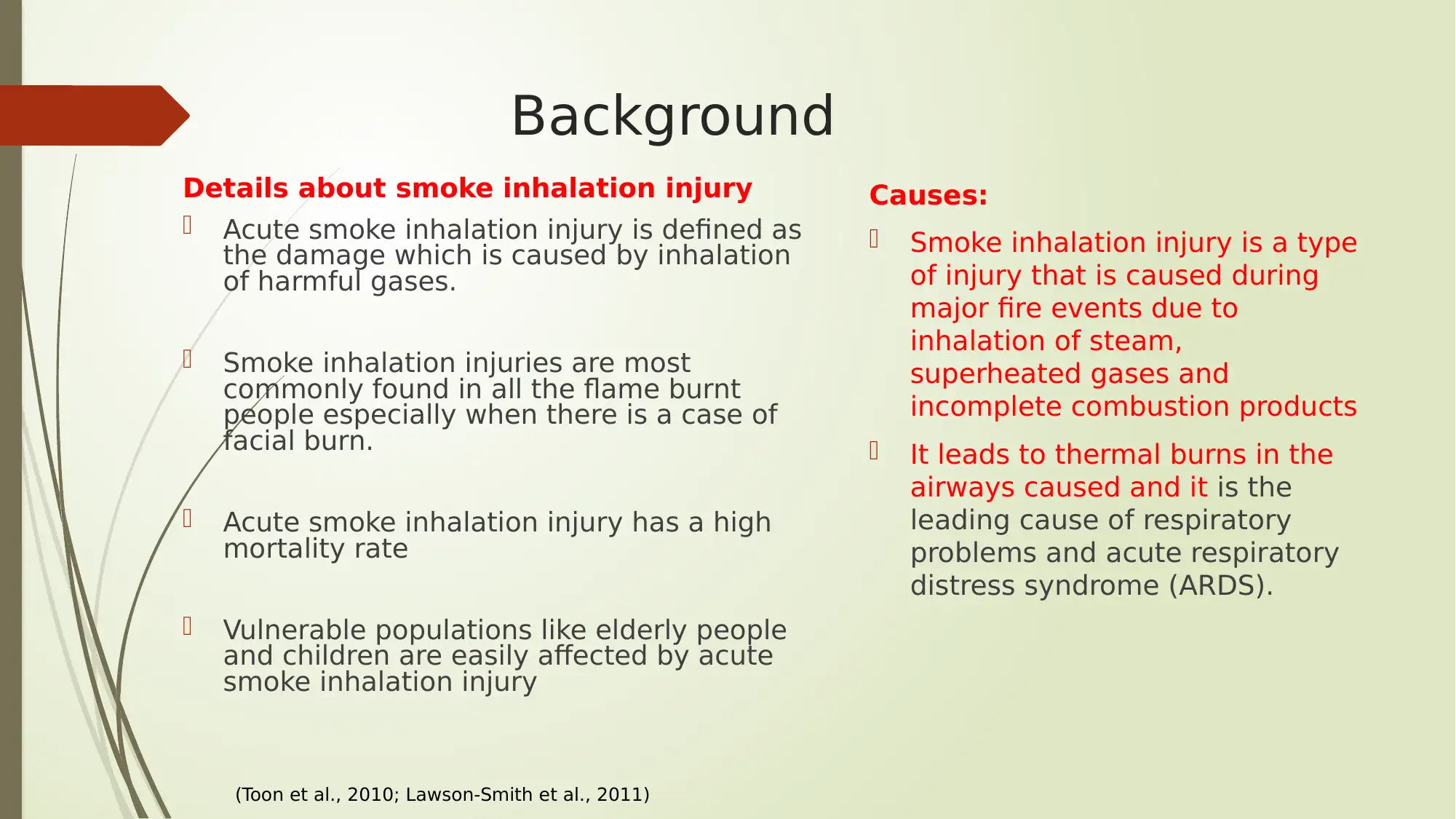
Background
Details about smoke inhalation injury
Acute smoke inhalation injury is defined as
the damage which is caused by inhalation
of harmful gases.
Smoke inhalation injuries are most
commonly found in all the flame burnt
people especially when there is a case of
facial burn.
Acute smoke inhalation injury has a high
mortality rate
Vulnerable populations like elderly people
and children are easily affected by acute
smoke inhalation injury
Causes:
Smoke inhalation injury is a type
of injury that is caused during
major fire events due to
inhalation of steam,
superheated gases and
incomplete combustion products
It leads to thermal burns in the
airways caused and it is the
leading cause of respiratory
problems and acute respiratory
distress syndrome (ARDS).
(Toon et al., 2010; Lawson-Smith et al., 2011)
Details about smoke inhalation injury
Acute smoke inhalation injury is defined as
the damage which is caused by inhalation
of harmful gases.
Smoke inhalation injuries are most
commonly found in all the flame burnt
people especially when there is a case of
facial burn.
Acute smoke inhalation injury has a high
mortality rate
Vulnerable populations like elderly people
and children are easily affected by acute
smoke inhalation injury
Causes:
Smoke inhalation injury is a type
of injury that is caused during
major fire events due to
inhalation of steam,
superheated gases and
incomplete combustion products
It leads to thermal burns in the
airways caused and it is the
leading cause of respiratory
problems and acute respiratory
distress syndrome (ARDS).
(Toon et al., 2010; Lawson-Smith et al., 2011)
Secure Best Marks with AI Grader
Need help grading? Try our AI Grader for instant feedback on your assignments.
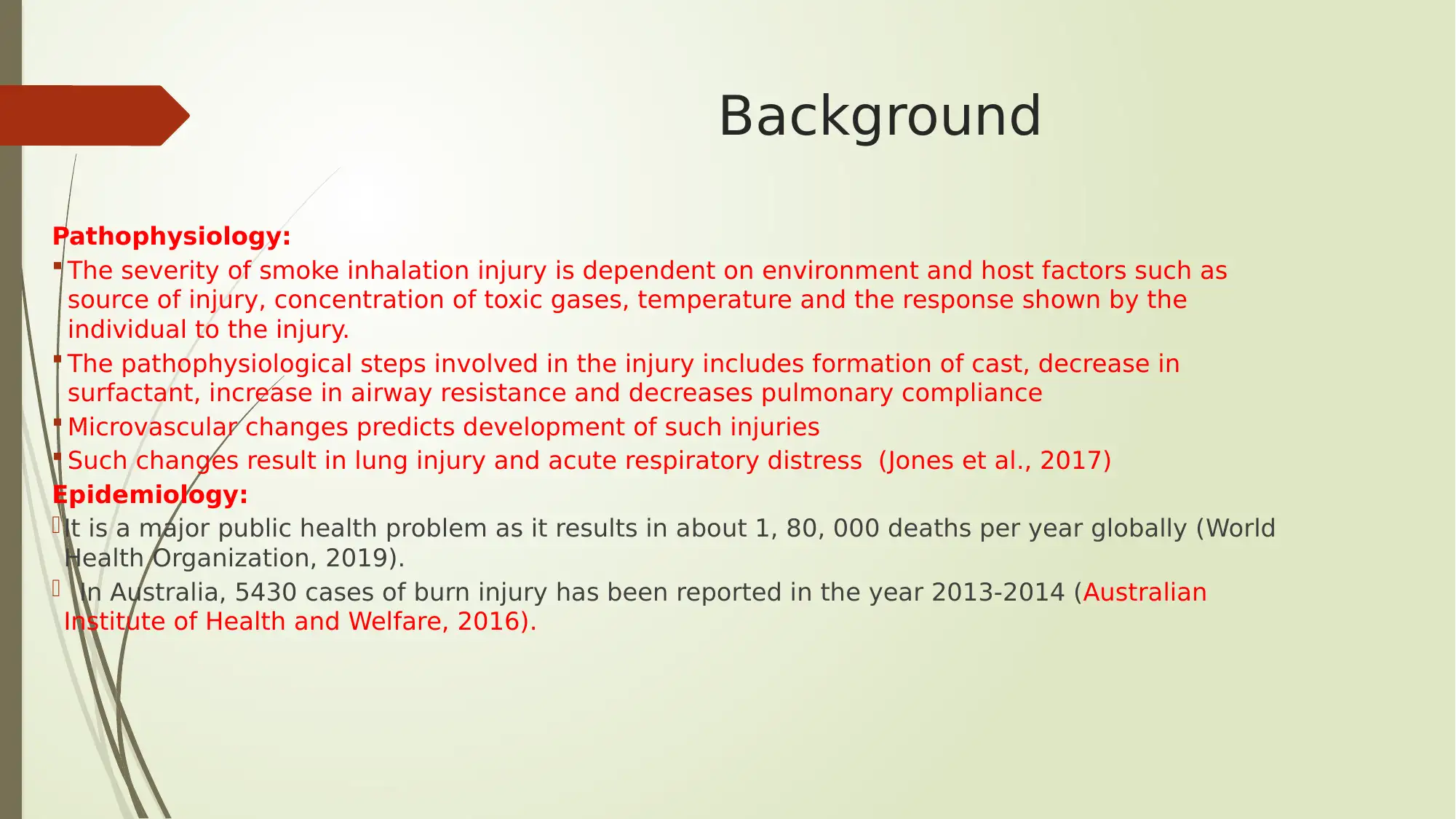
Background
Pathophysiology:
The severity of smoke inhalation injury is dependent on environment and host factors such as
source of injury, concentration of toxic gases, temperature and the response shown by the
individual to the injury.
The pathophysiological steps involved in the injury includes formation of cast, decrease in
surfactant, increase in airway resistance and decreases pulmonary compliance
Microvascular changes predicts development of such injuries
Such changes result in lung injury and acute respiratory distress (Jones et al., 2017)
Epidemiology:
It is a major public health problem as it results in about 1, 80, 000 deaths per year globally (World
Health Organization, 2019).
In Australia, 5430 cases of burn injury has been reported in the year 2013-2014 (Australian
Institute of Health and Welfare, 2016).
Pathophysiology:
The severity of smoke inhalation injury is dependent on environment and host factors such as
source of injury, concentration of toxic gases, temperature and the response shown by the
individual to the injury.
The pathophysiological steps involved in the injury includes formation of cast, decrease in
surfactant, increase in airway resistance and decreases pulmonary compliance
Microvascular changes predicts development of such injuries
Such changes result in lung injury and acute respiratory distress (Jones et al., 2017)
Epidemiology:
It is a major public health problem as it results in about 1, 80, 000 deaths per year globally (World
Health Organization, 2019).
In Australia, 5430 cases of burn injury has been reported in the year 2013-2014 (Australian
Institute of Health and Welfare, 2016).
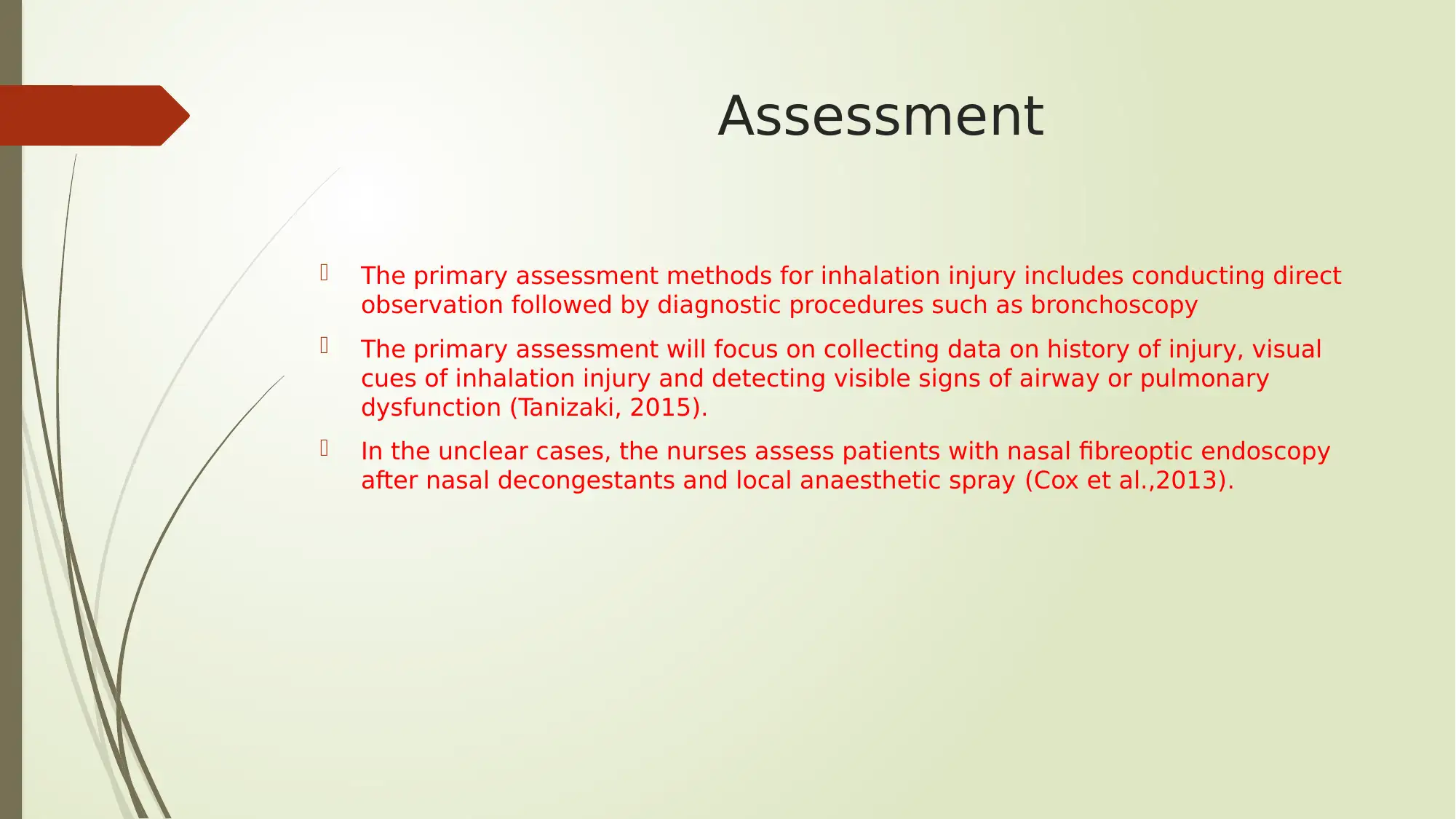
Assessment
The primary assessment methods for inhalation injury includes conducting direct
observation followed by diagnostic procedures such as bronchoscopy
The primary assessment will focus on collecting data on history of injury, visual
cues of inhalation injury and detecting visible signs of airway or pulmonary
dysfunction (Tanizaki, 2015).
In the unclear cases, the nurses assess patients with nasal fibreoptic endoscopy
after nasal decongestants and local anaesthetic spray (Cox et al.,2013).
The primary assessment methods for inhalation injury includes conducting direct
observation followed by diagnostic procedures such as bronchoscopy
The primary assessment will focus on collecting data on history of injury, visual
cues of inhalation injury and detecting visible signs of airway or pulmonary
dysfunction (Tanizaki, 2015).
In the unclear cases, the nurses assess patients with nasal fibreoptic endoscopy
after nasal decongestants and local anaesthetic spray (Cox et al.,2013).
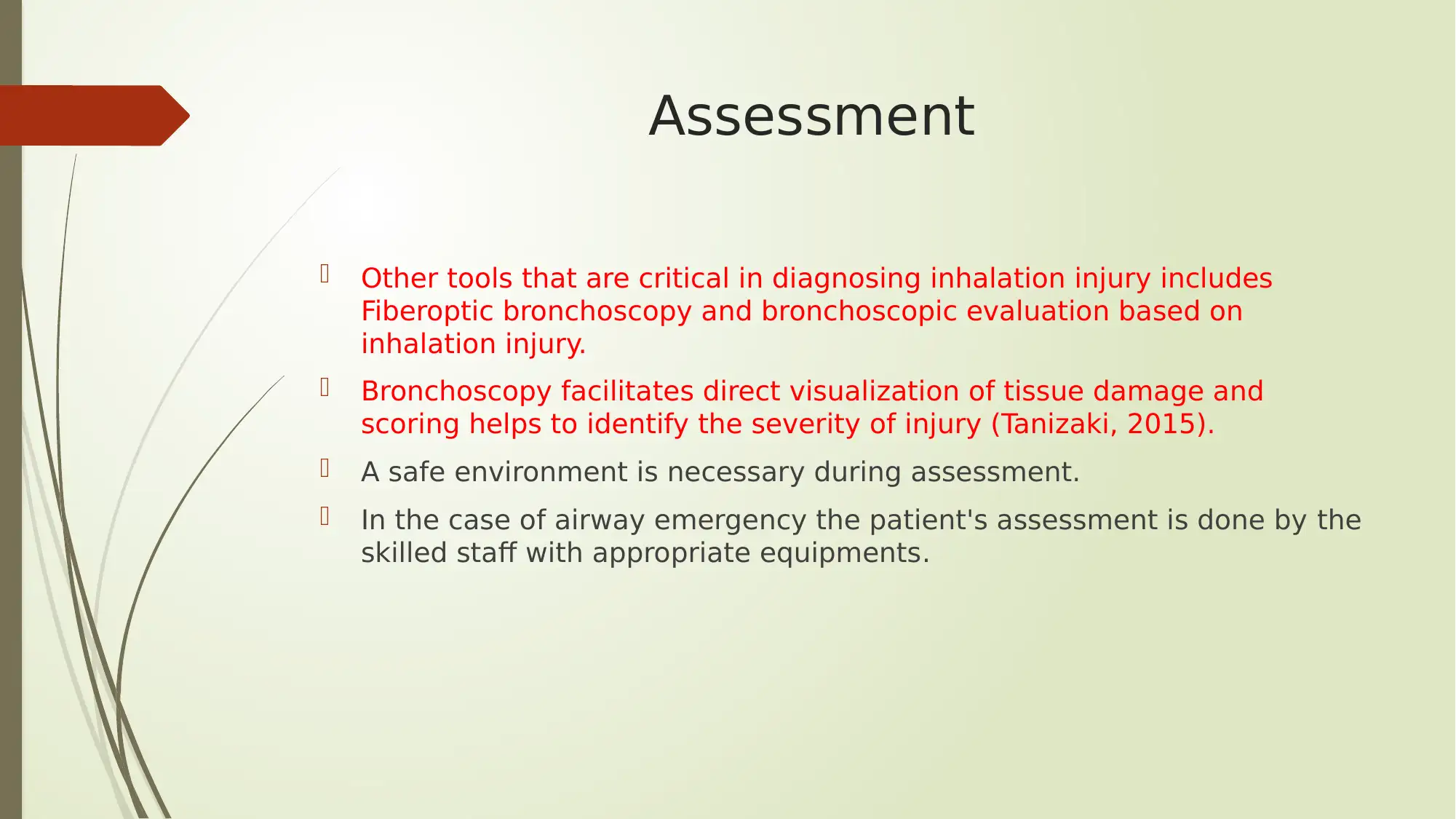
Assessment
Other tools that are critical in diagnosing inhalation injury includes
Fiberoptic bronchoscopy and bronchoscopic evaluation based on
inhalation injury.
Bronchoscopy facilitates direct visualization of tissue damage and
scoring helps to identify the severity of injury (Tanizaki, 2015).
A safe environment is necessary during assessment.
In the case of airway emergency the patient's assessment is done by the
skilled staff with appropriate equipments.
Other tools that are critical in diagnosing inhalation injury includes
Fiberoptic bronchoscopy and bronchoscopic evaluation based on
inhalation injury.
Bronchoscopy facilitates direct visualization of tissue damage and
scoring helps to identify the severity of injury (Tanizaki, 2015).
A safe environment is necessary during assessment.
In the case of airway emergency the patient's assessment is done by the
skilled staff with appropriate equipments.
Paraphrase This Document
Need a fresh take? Get an instant paraphrase of this document with our AI Paraphraser
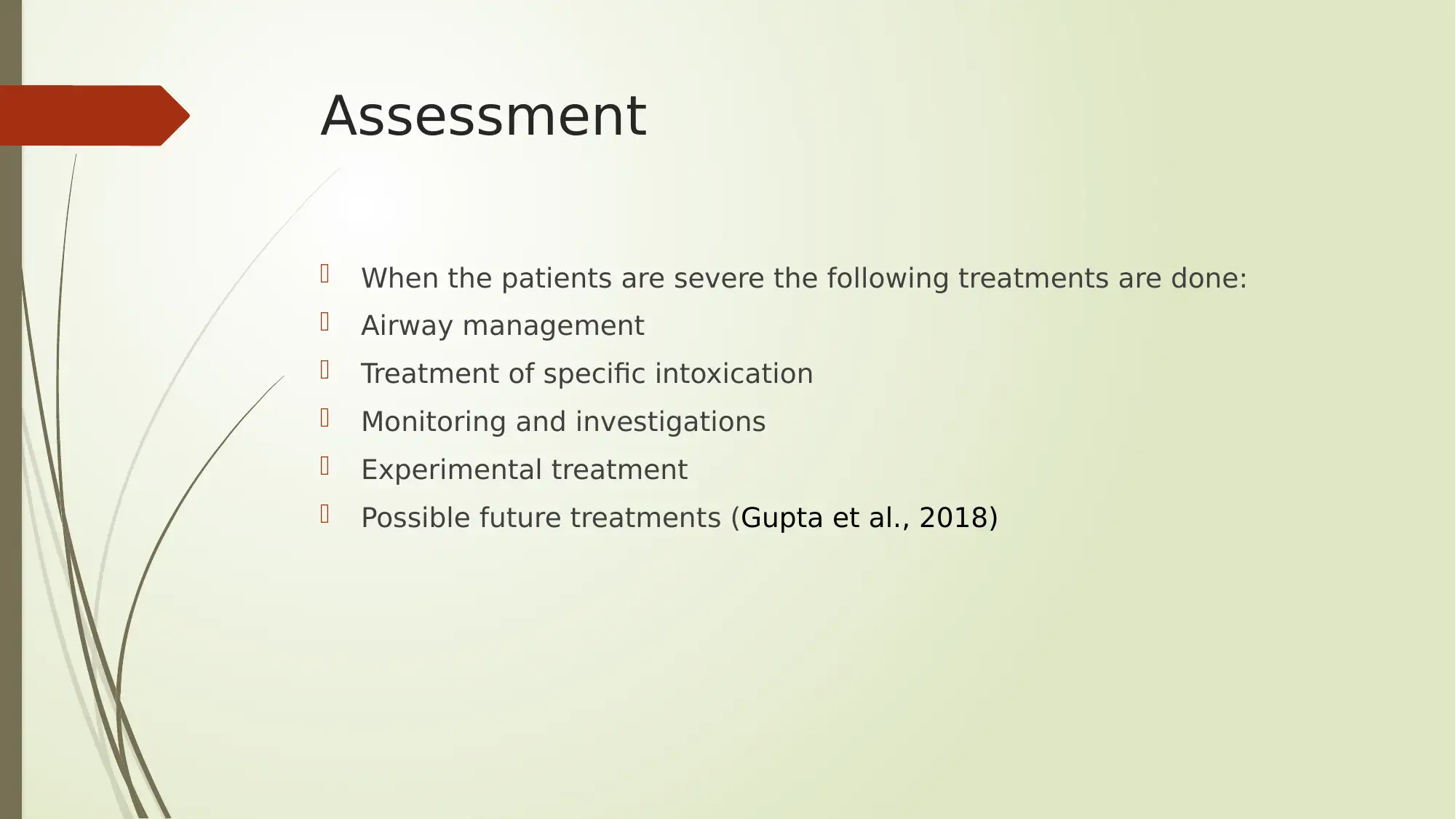
Assessment
When the patients are severe the following treatments are done:
Airway management
Treatment of specific intoxication
Monitoring and investigations
Experimental treatment
Possible future treatments (Gupta et al., 2018)
When the patients are severe the following treatments are done:
Airway management
Treatment of specific intoxication
Monitoring and investigations
Experimental treatment
Possible future treatments (Gupta et al., 2018)
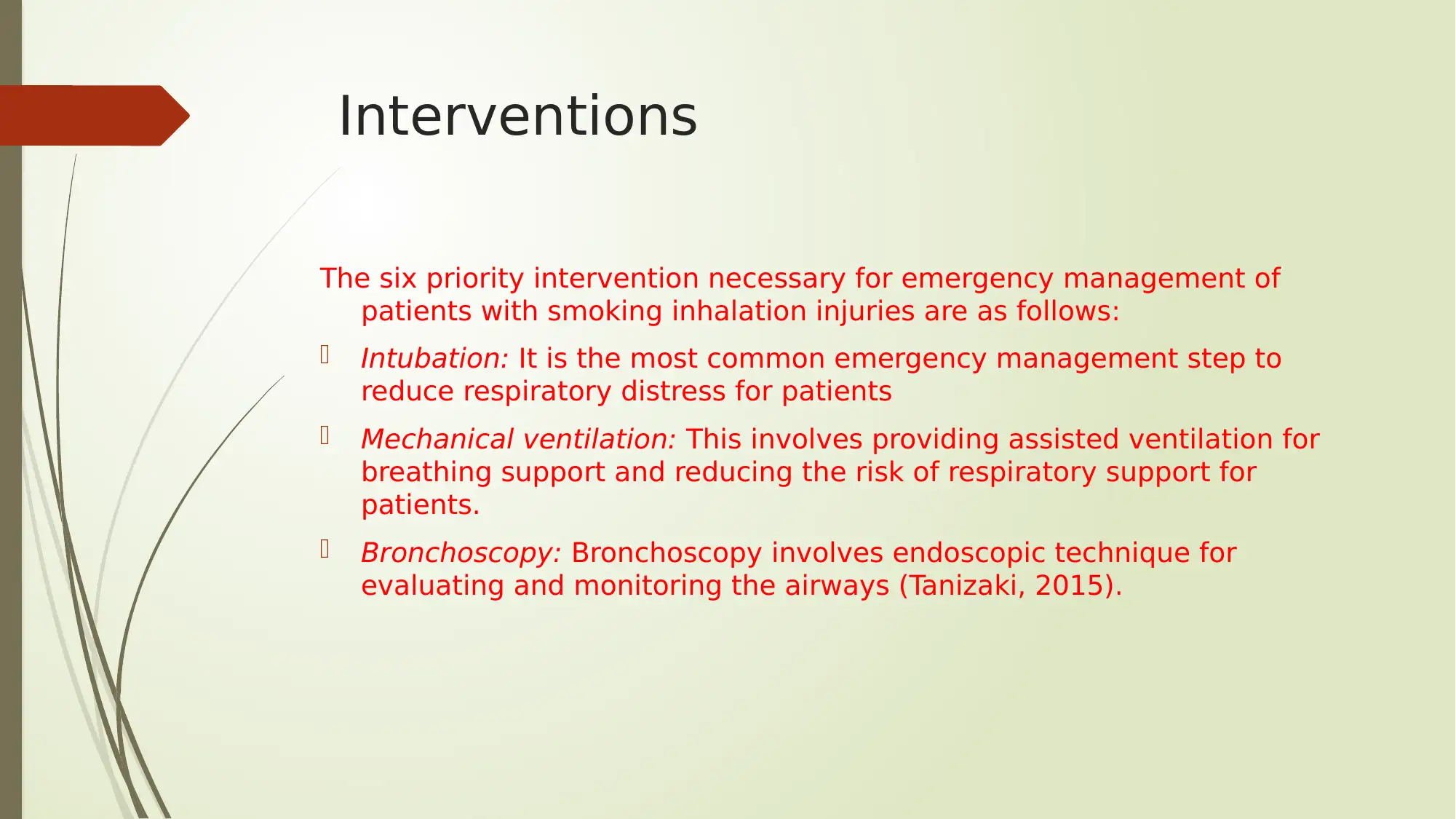
Interventions
The six priority intervention necessary for emergency management of
patients with smoking inhalation injuries are as follows:
Intubation: It is the most common emergency management step to
reduce respiratory distress for patients
Mechanical ventilation: This involves providing assisted ventilation for
breathing support and reducing the risk of respiratory support for
patients.
Bronchoscopy: Bronchoscopy involves endoscopic technique for
evaluating and monitoring the airways (Tanizaki, 2015).
The six priority intervention necessary for emergency management of
patients with smoking inhalation injuries are as follows:
Intubation: It is the most common emergency management step to
reduce respiratory distress for patients
Mechanical ventilation: This involves providing assisted ventilation for
breathing support and reducing the risk of respiratory support for
patients.
Bronchoscopy: Bronchoscopy involves endoscopic technique for
evaluating and monitoring the airways (Tanizaki, 2015).
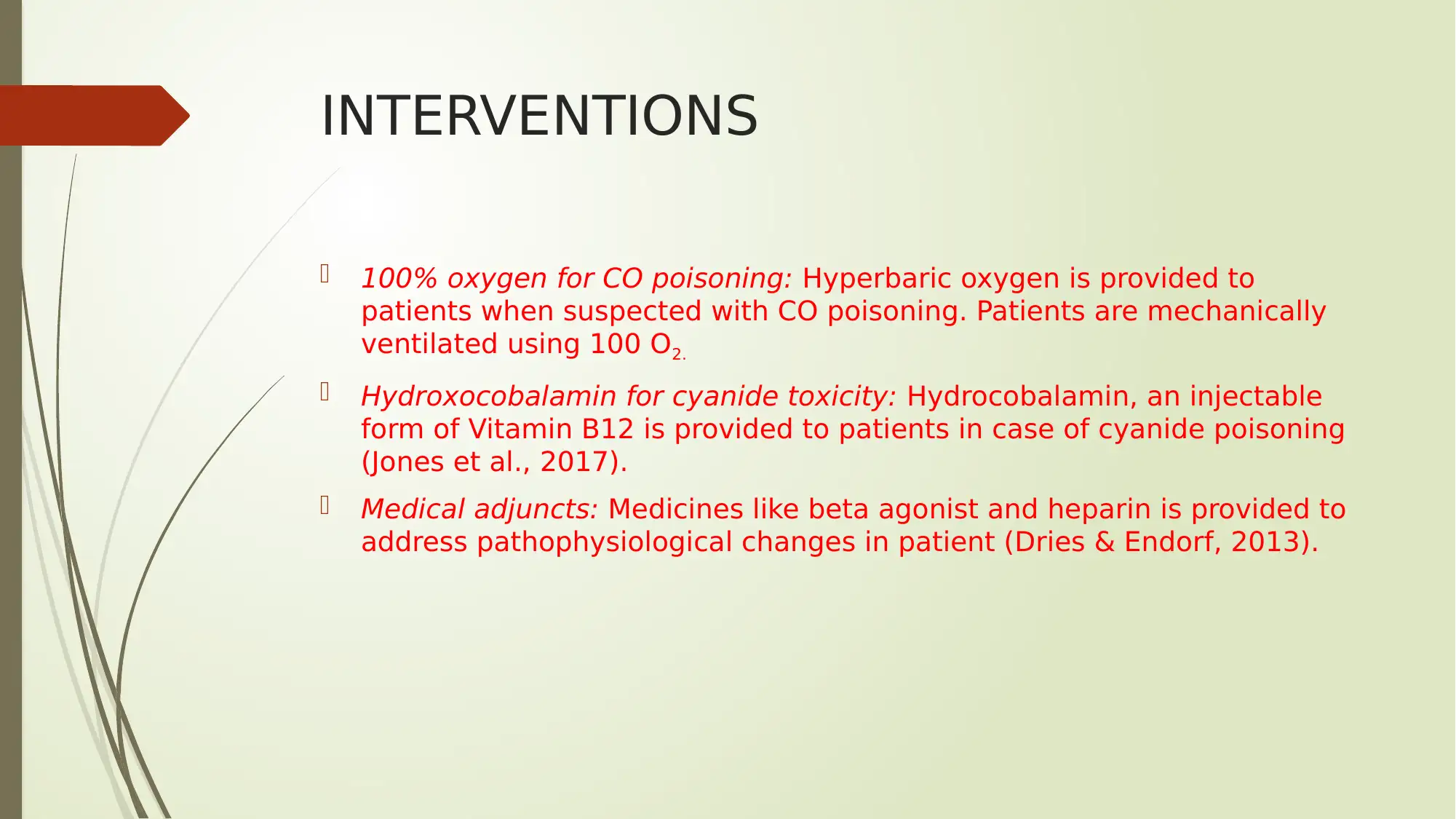
INTERVENTIONS
100% oxygen for CO poisoning: Hyperbaric oxygen is provided to
patients when suspected with CO poisoning. Patients are mechanically
ventilated using 100 O2.
Hydroxocobalamin for cyanide toxicity: Hydrocobalamin, an injectable
form of Vitamin B12 is provided to patients in case of cyanide poisoning
(Jones et al., 2017).
Medical adjuncts: Medicines like beta agonist and heparin is provided to
address pathophysiological changes in patient (Dries & Endorf, 2013).
100% oxygen for CO poisoning: Hyperbaric oxygen is provided to
patients when suspected with CO poisoning. Patients are mechanically
ventilated using 100 O2.
Hydroxocobalamin for cyanide toxicity: Hydrocobalamin, an injectable
form of Vitamin B12 is provided to patients in case of cyanide poisoning
(Jones et al., 2017).
Medical adjuncts: Medicines like beta agonist and heparin is provided to
address pathophysiological changes in patient (Dries & Endorf, 2013).
Secure Best Marks with AI Grader
Need help grading? Try our AI Grader for instant feedback on your assignments.
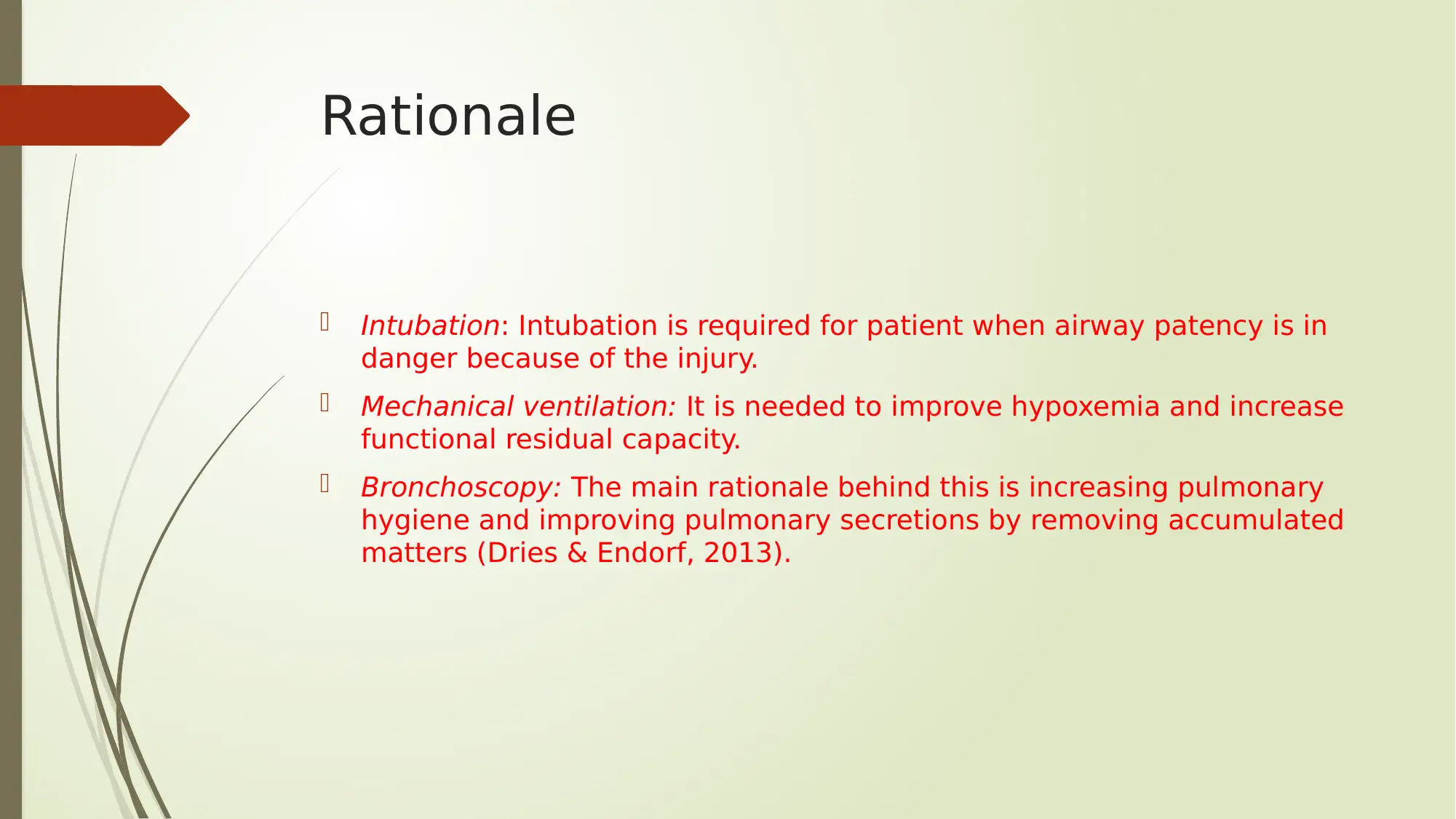
Rationale
Intubation: Intubation is required for patient when airway patency is in
danger because of the injury.
Mechanical ventilation: It is needed to improve hypoxemia and increase
functional residual capacity.
Bronchoscopy: The main rationale behind this is increasing pulmonary
hygiene and improving pulmonary secretions by removing accumulated
matters (Dries & Endorf, 2013).
Intubation: Intubation is required for patient when airway patency is in
danger because of the injury.
Mechanical ventilation: It is needed to improve hypoxemia and increase
functional residual capacity.
Bronchoscopy: The main rationale behind this is increasing pulmonary
hygiene and improving pulmonary secretions by removing accumulated
matters (Dries & Endorf, 2013).
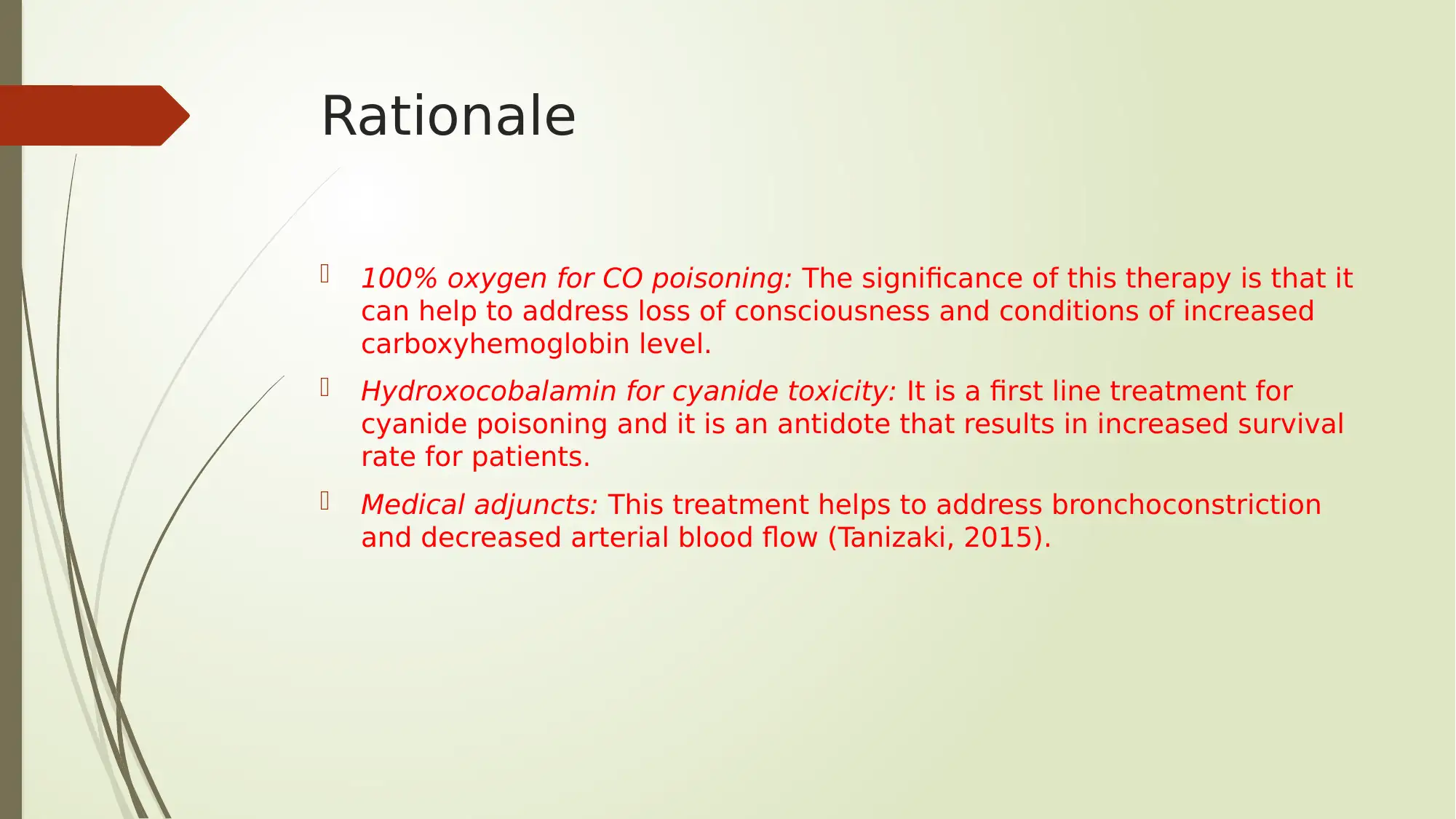
Rationale
100% oxygen for CO poisoning: The significance of this therapy is that it
can help to address loss of consciousness and conditions of increased
carboxyhemoglobin level.
Hydroxocobalamin for cyanide toxicity: It is a first line treatment for
cyanide poisoning and it is an antidote that results in increased survival
rate for patients.
Medical adjuncts: This treatment helps to address bronchoconstriction
and decreased arterial blood flow (Tanizaki, 2015).
100% oxygen for CO poisoning: The significance of this therapy is that it
can help to address loss of consciousness and conditions of increased
carboxyhemoglobin level.
Hydroxocobalamin for cyanide toxicity: It is a first line treatment for
cyanide poisoning and it is an antidote that results in increased survival
rate for patients.
Medical adjuncts: This treatment helps to address bronchoconstriction
and decreased arterial blood flow (Tanizaki, 2015).
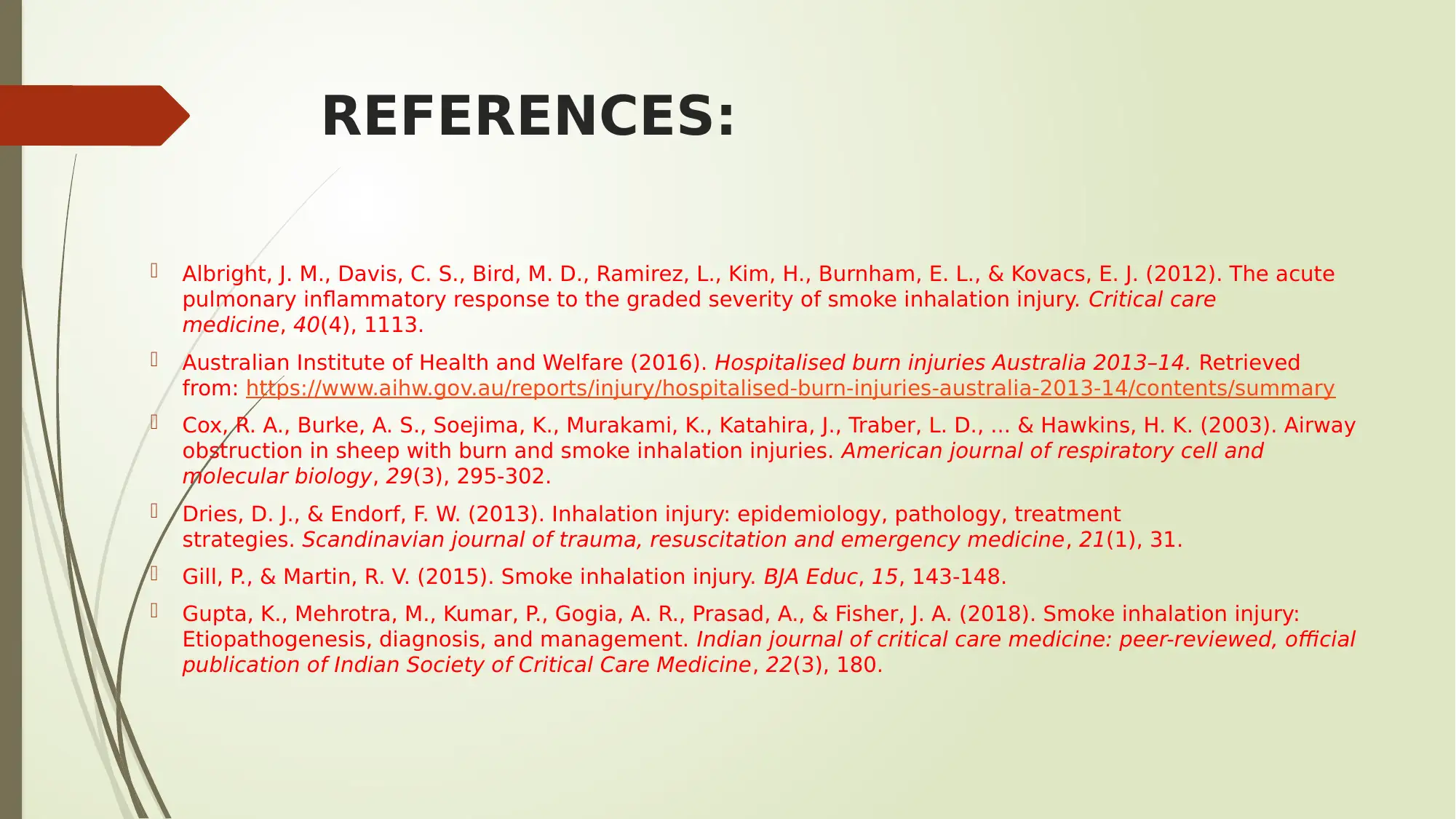
REFERENCES:
Albright, J. M., Davis, C. S., Bird, M. D., Ramirez, L., Kim, H., Burnham, E. L., & Kovacs, E. J. (2012). The acute
pulmonary inflammatory response to the graded severity of smoke inhalation injury. Critical care
medicine, 40(4), 1113.
Australian Institute of Health and Welfare (2016). Hospitalised burn injuries Australia 2013–14. Retrieved
from: https://www.aihw.gov.au/reports/injury/hospitalised-burn-injuries-australia-2013-14/contents/summary
Cox, R. A., Burke, A. S., Soejima, K., Murakami, K., Katahira, J., Traber, L. D., ... & Hawkins, H. K. (2003). Airway
obstruction in sheep with burn and smoke inhalation injuries. American journal of respiratory cell and
molecular biology, 29(3), 295-302.
Dries, D. J., & Endorf, F. W. (2013). Inhalation injury: epidemiology, pathology, treatment
strategies. Scandinavian journal of trauma, resuscitation and emergency medicine, 21(1), 31.
Gill, P., & Martin, R. V. (2015). Smoke inhalation injury. BJA Educ, 15, 143-148.
Gupta, K., Mehrotra, M., Kumar, P., Gogia, A. R., Prasad, A., & Fisher, J. A. (2018). Smoke inhalation injury:
Etiopathogenesis, diagnosis, and management. Indian journal of critical care medicine: peer-reviewed, official
publication of Indian Society of Critical Care Medicine, 22(3), 180.
Albright, J. M., Davis, C. S., Bird, M. D., Ramirez, L., Kim, H., Burnham, E. L., & Kovacs, E. J. (2012). The acute
pulmonary inflammatory response to the graded severity of smoke inhalation injury. Critical care
medicine, 40(4), 1113.
Australian Institute of Health and Welfare (2016). Hospitalised burn injuries Australia 2013–14. Retrieved
from: https://www.aihw.gov.au/reports/injury/hospitalised-burn-injuries-australia-2013-14/contents/summary
Cox, R. A., Burke, A. S., Soejima, K., Murakami, K., Katahira, J., Traber, L. D., ... & Hawkins, H. K. (2003). Airway
obstruction in sheep with burn and smoke inhalation injuries. American journal of respiratory cell and
molecular biology, 29(3), 295-302.
Dries, D. J., & Endorf, F. W. (2013). Inhalation injury: epidemiology, pathology, treatment
strategies. Scandinavian journal of trauma, resuscitation and emergency medicine, 21(1), 31.
Gill, P., & Martin, R. V. (2015). Smoke inhalation injury. BJA Educ, 15, 143-148.
Gupta, K., Mehrotra, M., Kumar, P., Gogia, A. R., Prasad, A., & Fisher, J. A. (2018). Smoke inhalation injury:
Etiopathogenesis, diagnosis, and management. Indian journal of critical care medicine: peer-reviewed, official
publication of Indian Society of Critical Care Medicine, 22(3), 180.
Paraphrase This Document
Need a fresh take? Get an instant paraphrase of this document with our AI Paraphraser
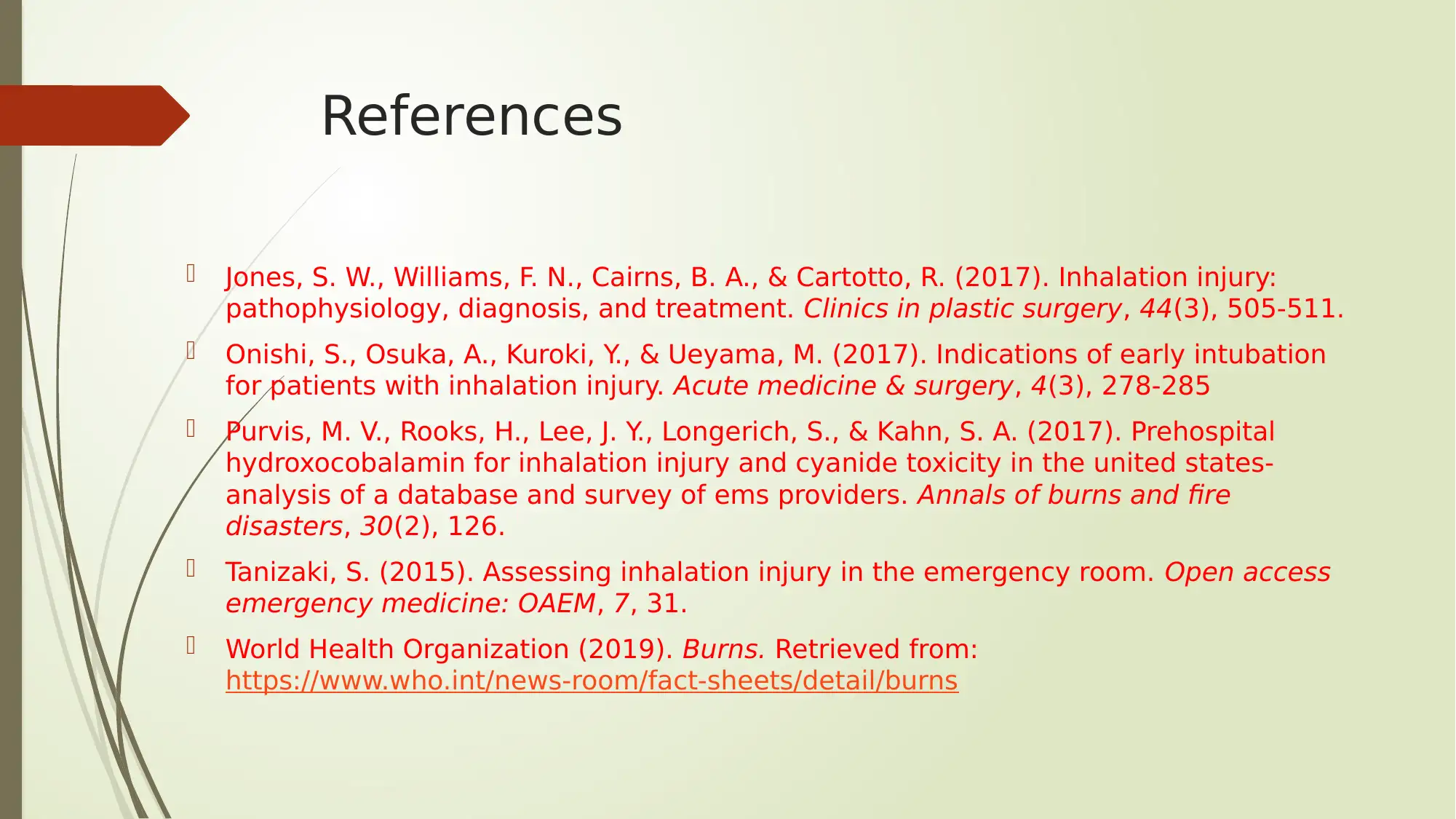
References
Jones, S. W., Williams, F. N., Cairns, B. A., & Cartotto, R. (2017). Inhalation injury:
pathophysiology, diagnosis, and treatment. Clinics in plastic surgery, 44(3), 505-511.
Onishi, S., Osuka, A., Kuroki, Y., & Ueyama, M. (2017). Indications of early intubation
for patients with inhalation injury. Acute medicine & surgery, 4(3), 278-285
Purvis, M. V., Rooks, H., Lee, J. Y., Longerich, S., & Kahn, S. A. (2017). Prehospital
hydroxocobalamin for inhalation injury and cyanide toxicity in the united states-
analysis of a database and survey of ems providers. Annals of burns and fire
disasters, 30(2), 126.
Tanizaki, S. (2015). Assessing inhalation injury in the emergency room. Open access
emergency medicine: OAEM, 7, 31.
World Health Organization (2019). Burns. Retrieved from:
https://www.who.int/news-room/fact-sheets/detail/burns
Jones, S. W., Williams, F. N., Cairns, B. A., & Cartotto, R. (2017). Inhalation injury:
pathophysiology, diagnosis, and treatment. Clinics in plastic surgery, 44(3), 505-511.
Onishi, S., Osuka, A., Kuroki, Y., & Ueyama, M. (2017). Indications of early intubation
for patients with inhalation injury. Acute medicine & surgery, 4(3), 278-285
Purvis, M. V., Rooks, H., Lee, J. Y., Longerich, S., & Kahn, S. A. (2017). Prehospital
hydroxocobalamin for inhalation injury and cyanide toxicity in the united states-
analysis of a database and survey of ems providers. Annals of burns and fire
disasters, 30(2), 126.
Tanizaki, S. (2015). Assessing inhalation injury in the emergency room. Open access
emergency medicine: OAEM, 7, 31.
World Health Organization (2019). Burns. Retrieved from:
https://www.who.int/news-room/fact-sheets/detail/burns
1 out of 14
Related Documents
Your All-in-One AI-Powered Toolkit for Academic Success.
+13062052269
info@desklib.com
Available 24*7 on WhatsApp / Email
![[object Object]](/_next/static/media/star-bottom.7253800d.svg)
Unlock your academic potential
© 2024 | Zucol Services PVT LTD | All rights reserved.




